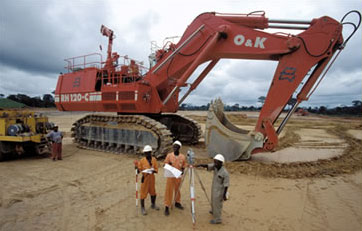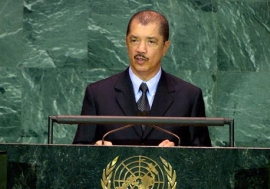More policy freedom or belt-tightening?
More policy freedom or belt-tightening?
Rather than “graduating” from the much-criticized economic reform programmes promoted by the International Monetary Fund (IMF), a number of African countries are opting to sign on to an extended version. The Fund describes its new Policy Support Instrument (PSI), introduced in 2005, as a “non-financial mechanism.” Unlike other IMF programmes, it does not come with any direct financing from the Fund. Instead countries receive IMF advice, monitoring and endorsement of their policies. So far six countries, all of them African, have signed on to the instrument, and more are considering doing so.
 Mozambique hopes to hire many more teachers for its overcrowded schools, but the low inflation targets set by the IMF limit public spending and may jeopardize that goal.
Mozambique hopes to hire many more teachers for its overcrowded schools, but the low inflation targets set by the IMF limit public spending and may jeopardize that goal.Under the PSIs, the IMF helps low-income countries design their economic programmes. If a country manages to meet set standards, the Fund then informs donors, multilateral development banks and private financiers that the country has “strong policies.” The targets set in PSIs are derived from earlier IMF and World Bank programmes and reviews are carried out every six months.
Some countries with PSIs, such as Mozambique, are already finding that these conditions make it difficult for them to spend more money to improve education and meet other internationally agreed Millennium Development Goals (MDGs).
“It is basically a standard IMF programme without the loans, but with the standard ‘structural adjustment’ provisions (privatization, liberalization, spending cuts, etc.), and the usual very low inflation targets,” argues Soren Ambrose of the Kenya-based non-governmental organization (NGO) Solidarity Africa Network. If a PSI country fails to attain IMF certification, he adds, the consequences can be serious. “When the IMF cuts a country off, the other official agencies generally follow suit. It is this ‘gatekeeper’ function, rather than the IMF’s loans, that give it its greatest power.”
A good IMF report makes it easier for a country to obtain World Bank loans and debt relief or to have its debt restructured at the Paris Club, a group of rich creditor governments. Such “cross-conditionality” can be a powerful instrument. Some poor countries that would otherwise not be eligible for relatively lower-interest loans from international money markets are turning to the PSI to get the IMF endorsement. Therefore, Mr. Ambrose maintains, the PSI potentially “seduces or pressures countries into signing on,” instead of permitting them to move away from IMF programmes altogether.
So far Cape Verde, Mozambique, Nigeria, Tanzania, Senegal and Uganda have signed on to PSIs, and Ghana is currently negotiating the terms of one.
IMF seal of approval
In a statement explaining the PSIs, the IMF argues that it is performing a needed service by “signalling” its views on policies to private creditors and donors “who may be interested in reassurance about the countries they are supporting.” The IMF had already been playing such a role in low-income countries through its lending programme, the Poverty Reduction and Growth Facility (PRGF). “A number of countries — what we call mature stabilizers — said ‘We want to graduate from the PRGF, but we want to have the framework that can signal very strong policies’,” explains Patricia Alonso-Gamo of the IMF’s Policy Development and Review Department. “They didn’t want to have what other countries had at the time: intensified surveillance or fund-monitored programmes. They said ‘We want something stronger that is endorsed by the Fund’s Executive Board, and we can tell the world we have strong policies.’ So it was very much demand-driven.”
 Earth movers at a Ghana construction site. The government hopes that a new IMF agreement will make it easier to secure commercial loans for major road and other infrastructure projects.
Earth movers at a Ghana construction site. The government hopes that a new IMF agreement will make it easier to secure commercial loans for major road and other infrastructure projects.In efforts to recover from economic crises, most countries in sub-Saharan Africa began implementing IMF- and World Bank–led structural adjustment programmes during the 1980s. Those programmes promoted policies to expand the role of the market and reduce that of the state in economic affairs. They curtailed public spending for education and health care, privatized state-owned enterprises and liberalized trade. “African governments had to cede control over their economic decision-making in order to qualify for World Bank and IMF loans,” notes Africa Action, a US-based NGO.
Public discontent mounted over the social impact of these programmes as large numbers of workers lost their jobs and many poor people could not afford the rising costs of health care and education. In response to the protests and criticisms, the IMF and World Bank shifted course. They now require governments to prepare antipoverty programmes in consultation with civil society and other stakeholders in order to receive new loans or debt relief. The IMF renamed its structural adjustment lending facility the PRGF.
Access to cheap loans
One of the main motivations for countries to sign on to a PSI is that IMF endorsement makes it easier for them to borrow on international money markets at relatively low interest rates after “graduating” from a PRGF. Regarded as a “mature stabilizer,” Ghana decided not to renew its PRGF programme last year and is currently negotiating the terms of a PSI with the IMF. Having exhausted existing avenues for grants and concessional loans from the World Bank and the IMF, the country estimates that it needs to borrow $750 mn from commercial financial markets for infrastructure projects. Such infrastructure investment, the IMF believes, will help raise economic growth to 8.5 per cent per year and put Ghana on track towards middle-income status.
“In the long run,” says Roger Nord, assistant director of the IMF’s Africa Department, “growth and employment are not going to come from more foreign aid. They are going to come from private investment.”
Ghanaian government officials maintain that the conditions attached to earlier PRGF loans were onerous and excessive, prompting its decision to consider a PSI. Such conditionality has been one of the most controversial aspects of IMF and World Bank lending. Critics often claim that the institutions do not pay adequate attention to the social impact of the conditions or the sometimes contradictory ways in which multiple conditions interact with one another. Many governments feel that the conditions infringe on their sovereignty and fail to address the basic structural problems hindering their economic development.
On average, poor countries face 67 conditions per loan from the World Bank, according to a study by Eurodad, a network of European NGOs. In extreme cases, there can be as many as 200 conditions, as in a World Bank poverty-reduction grant to Uganda in 2005.
The IMF has increased its own use of conditionality since the 1990s and has extended its conditions beyond the Fund’s traditional fields of monetary and fiscal policy into trade, pricing, marketing, public sector management, public enterprises, agriculture and energy, and recently even to governance, an area in which it previously did not claim to have expertise. As a result, notes Eurodad, criticisms of IMF conditionality have “tended to centre on its loss of focus, on imposing an excessive number of structural conditions, trying to do too many things at the same time, and on expanding Fund influence beyond its area of competence.”
Conditionality has been one of the most controversial aspects of IMF and World Bank lending. Critics often claim that the institutions do not pay adequate attention to the social impact of the conditions, and governments feel that the conditions infringe on sovereignty.
After Tanzania signed on to a PSI, the East African, a regional newspaper, commented that “even without receiving IMF funds, the country will still be subject to IMF conditionalities.”
The Ghanaian government hopes to see a reduction in the number of conditions it will have to meet under a PSI, although that remains to be seen. Finance Minister Kwadwo Baah-Wiredu says that his “government sees this as a major turning point in the economic history of Ghana and will be approaching it with all the necessary precautions.”
Action Aid International, a South African–headquartered antipoverty group, conducted a comparison of PRGFs and PSIs in Uganda, Cape Verde, Tanzania and Mozambique and found little difference between the two mechanisms. In Uganda both programmes set similar targets on inflation and antipoverty spending. In Cape Verde, the PSI requires the government to limit inflation and refrain from new short-term borrowing and sets detailed benchmarks for financial sector reform. Where comparisons are possible, reports Action Aid International, the PSIs appear to carry over PRGF standards, but with incrementally more ambitious targets. Basically, argues the group, the IMF continues to play a major role in managing the economies of these poor countries, something it does not attempt to do in wealthier nations.
No money for teachers
The IMF commonly insists that governments set low inflation targets. Mozambique, under a PSI, now has a lower inflation target than it did in its last PRGF. In theory, keeping inflation down is good. But if government spending is curtailed excessively to help achieve that goal, other problems can emerge.
In Mozambique, notes Action Aid International, it means that the government will not be able to hire more teachers to reduce the overcrowding in schools. The current pupil-teacher ratio is 72:1, but the government’s Education for All initiative recommends reducing it to 40:1. Unless the government significantly increases spending to recruit more teachers, it will only attain a ratio of 50:1 by 2015.
Mozambique is also facing difficulties reaching the universal primary education target set under the MDGs, notes Action Aid International in a 2007 report, The IMF’s Policy Support Instrument: Expanded Fiscal Space or Continued Belt-Tightening?
In 2004, the government and IMF agreed under the PRGF to limit spending on the government wage bill to 6.5 per cent of the gross domestic product (GDP). Teachers account for 35 per cent of all government employees, so the following year Mozambique was able to hire only 4,700 teachers, instead of the 11,500 it needed. The IMF then agreed to raise the ceiling to 7.5 per cent of GDP in 2006, allowing the recruitment of 9,000 new teachers. However, notes the Action Aid International study, the IMF and Ministry of Finance also further lowered the PRGF’s inflation target and agreed to cut back government borrowing even more. “These policies also appear in the new PSI,” observes Action Aid International. “Overly prudent macroeconomic policies mean that there is little scope now to raise the wage bill ceiling higher even though more teachers are needed in schools.”
The PSI does allow priority sectors such as education and health to receive a major share of the national budget, Action Aid International acknowledges, but not enough to “allow for the scaling-up required to meet the MDGs and the Education for All objectives. As a result, Mozambique will fall short of its target to provide quality primary education to all children by 2015.”
Continued IMF relevance?
The PSI is open to countries that were successfully implementing an IMF/World Bank poverty reduction programme or that qualify for the PRGF. However, says Ms. Alonso-Gamo of the IMF, the new plan was specifically designed for “mature stabilizers” — countries that have regularly achieved reasonable growth rates and low inflation levels, that possess adequate international financial reserves and that have begun to achieve manageable levels of debt. Some of these countries no longer need IMF financial assistance and have asked to “graduate” from the PRGF, while still maintaining ties with the Fund, she explains.
Action Aid International, however, sees the introduction of the PSI as an attempt by the IMF to remain relevant in a changing international monetary environment. The PSI was unveiled amid growing questions about the role of the IMF in the global economy. In 2005, when the PSI was launched, the Group of Eight industrialized nations announced the Multilateral Debt Relief Initiative, which would, for the first time, cancel 100 per cent of the debts owed to the IMF by some of its most impoverished client countries. The elimination of these countries’ debt obligations has raised the possibility that some could consider foregoing further IMF involvement.
“The PSI was apparently designed for newly unburdened countries that might be tempted to chart their own course, as an enticement to remain in the IMF fold,” notes Action Aid International. It was also introduced at a time when early repayments by the IMF’s largest debtors, such as Argentina, raised wider questions about whether middle-income countries would stop working with the IMF, possibly provoking financial shortfalls for the Fund.
As a result, comments Action Aid International, the Fund may be seeking to “adjust its image as the tough lender and disciplinarian to a more collegial sort of adviser. But even as the IMF tries to adopt a gentler image, the policies contained in PSIs remain consistent with the standard IMF austerity programmes that have proved deeply controversial over the last 25 years.”
















